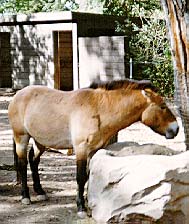Przewalski
Asiatic Wild Horse, Mongolian Wild Horses, Taki
Sat, 7th June, 2025 - 12:54 pm GMT
Sponsor Ads:

Alternative Name
Asiatic Wild Horse, Mongolian Wild Horses, TakiBasic Info
The Przewalski is a heavily built horse. It stands typically between 12 and 14 hands. Its color is beige-brown or dun with a light colored muzzle. It has a black stripe over its back, called "eel-stripe" and stripes across its legs like a zebra. It has an upright mane, which unlike a Fjord pony's, does not fall over if it is not cut. The mane stops between the ears, hence the Przewalski horse has no forelock. The tail of the Przewalski is also different from the domestic horse. In the domestic horse the hairs on the tail start at the top, tight where the tail is implanted on the body, but the Przewalski horse, as in the asses, the dock hairs are short and the longer hairs only start lower down. In a sandstorm he would turn his head with eyes and nose away from the fierce wind and the driven sand grains and protect the vulnerable parts of his rear with the tail. The mane and tail are dark in color
Health
N/AHabitat
N/ABehavior
N/AOrigin
AsiaHistory
Twenty thousand years ago wild horses roamed over the whole of Europe and Asia. Our prehistoric ancestors hunted them intensively as we have learned from the many caves discovered in the last hundred years, especially in France and Spain, where wall paintings abound. In most of the caves, pictures of horses far exceeded pictures of any other species, so we may assume that they were abundant. During this period there were comparatively few human beings and therefore posed little threat to the environment. These early people were very dependent upon nature for their survival. In the course of time primitive agriculture and livestock rearing began to be practiced, and some of the animals that had previously been hunted became the enemies of the early farmers. Of all the wild creatures the horse was the one that gave them the most trouble. It broke into the enclosures and grazed on the crops raised on the hard won land and moreover the wild stallions were in the habit of taking with them the tame mares that were kept for meat. As time went on and agriculture spread, the population of humans and domestic cattle increased and the enclosing of more land meant that the wild horses were driven even further off into areas that were not suitable for cultivation. The increasing demands of men were not the only threat to the wild horses. After the last ice-age the steppes, which provided the most suitable terrain for them, gave way to woods and forests to which they were less well adapted, although there were herds still in existence in many parts of Europe in the fourteenth and fifteenth centuries. By the nineteenth century herds were confined to Poland and Southern Russia, although there was already some doubt as to whether these were really of original wild stock or whether they had run wild. In any event, while the scientists argued and the discussion raged, these herds became extinct. It is interesting to note, in this connection, that the great Swedish scientist, Linnaeus (1707- 1778) did not include the wild horse in his ‘system naturae’ wherein he classified all living things. It therefore caused a great sensation when Colonel Nikolai Przewalski, who made voyages of discovery into Central Asia by order of the Czar, announced that he had heard of wild horses still in existence in Southwest Mongolia. From his second voyage of discovery he brought back the skull and hide of a wild horse that had been given him by a frontier guard. During his third journey he himself saw two herds of these animals in the Tachin Schara Nuru Mountains near the edge of the Gobi desert. Because in the ‘system naturae’ the name of a new species always includes the name of its discoverer this wild horse received the complicated name of Przewalski’s horse. (More recent information that has come to light indicates, however, that two European explorers observed this animal at much earlier dates.) In 1881, Przewalski made an official statement describing their appearance, their remote and deserted habitat and their characteristics. They lived in herds from five to fifteen animals led by a stallion. He noted that they were alert and very shy, with acute hearing, very good eyesight and a highly developed sense of smell. They seemed to prefer saline soils and could survive for a long time without water. By the end of the century, news of Colonel Przewalski’s discovery has spread throughout Europe and America. There were at the same time several large landowners who had become interested in rare animals, among them Frederic von Falz-Fein, who kept many rare species on his vast estates at Askania Nova in Southern Russia. When he heard of the discovery of the wild horses in Mongolia he ordered Asanov, a dealer in Kodbo, to organize an expedition to capture some of these animals. It proved impossible, however, to catch the full-grown horses. They were too shy and too fast. The only chance of capture was to try for the foals. It seems likely that the first attempt was made in 1897, without success. In 1898, two foals were caught; their captors had intended rearing them on sheep’s milk, but this failed and both foals died soon after being taken. In view of this, von Falz-Fein decided to try and obtain local in-milk mares. Elaborate arrangements were made with the local inhabitants to use their mares as "stepmothers" for the captured foals. In 1899, seven foals were captured and reared by the imported mares and of these four eventually arrived at Askania Nova. The whole expedition had cost von Falz-Fein over ten thousand rubles, a very considerable sum when you realize that one ruble was the price paid in Mongolia for five hundred pounds of tea. One foal caught in 1899 and one filly caught in 1900, were presented to Czar Nicholas II. The filly soon died and subsequently the Czar gave the stallion to von Falz-Fein so that he could start breeding his wild-caught fillies. In 1900 two more colts were caught and were transferred to Moscow. The first Duke of Bedford, like von Falz-Fein, was a great lover of nature. He was, among other things Chairman of the Zoological Society of London, and he kept many rare species of birds and animals at his Woburn estate. The Duke was very interested in acquiring some Przewalski horses so he commissioned Carl Hagenbeck, the great animal dealer in Hamburg, to obtain some for him. As a result of this and the pressure from other collectors in Europe and the United States, another fifty-one wild foals were caught in 1901. Of these only twenty-eight survived the hardships of the seven month journey to Europe. Twelve of them went to the Duke of Bedford’s Woburn estate, two to Halle, two to Berlin and two to Gooilust in the Netherlands. Two were shipped to New York and later transferred to Cincinnati. Two went to London, two to Manchester, one to Paris and three stayed in Hamburg. More foals were caught in the following two years, but only fourteen survived to reach their final destination, of these some were in such poor condition on arrival that they did not long survive. Only 53 of these survived the rough voyage from Mongolia to Europe. They were dispersed over a number of zoos and privately owned parks. All the captive Przewalski horses of today are descended from only 13 of these ancestors. Until the Second World War the number of Przewalski horses living in the wild appears to have remained stable. Although there were regular reports of small herds being sighted, the total population could not have been very great, and after the war the numbers quickly declined. Since 1967, no herds of wild Przewalski horses have been seen in Southwest Mongolia, inspite of several expeditions sent out specifically to look for them. The last wild Przewalski horse was sighted in 1969 near a spring called Gun Tamga. Breeding the Przewalski horse in captivity was not easy. In many cases the animals did not have enough space, and often there was no grass. Moreover, there was insufficient exchange of animals between zoos. Stallions would often cover their own daughters and granddaughters. Such inbreeding raised the chances of congenital diseases and defects. Inbreeding has already caused great damage, including a diminished life span and increased mortality among foals. The number of pregnancies also decreased. The situation of the Przewalski horse was critical. Something had to be done to save the last wild horse from extinction.Common Foods
grassSponsor Ads:
It doesn't much matter whom you marry, for tomorrow morning you discover that it was someone else. -- Unknown
Przewalski
Coded by: BGID® | ALL RIGHTS RESERVED Copyright © 2000-2025
Disclaimer | Privacy | Report Errors / Contact | Credits








 President of the United States of America - Real Estate mogul, Pageant owner and now one of the most controversial men in political history.
President of the United States of America - Real Estate mogul, Pageant owner and now one of the most controversial men in political history.  Politician, US Vice President and President of the USA - Joseph Robinette Biden Jr.
Politician, US Vice President and President of the USA - Joseph Robinette Biden Jr.  versus
versus  Russia: 'The Evil Empire'? Are they all that bad or is it just the USA trying to portray Russia as bad because they are a world power with land bigger and a society very different from the USA ideal?
Russia: 'The Evil Empire'? Are they all that bad or is it just the USA trying to portray Russia as bad because they are a world power with land bigger and a society very different from the USA ideal?  Global warming has been in and out as the "latest" hot topic for many years. It is, according to modern scientists, the result of man-made industrial pollutants, clearing forested areas, agriculture, etc. But now they are thinking it started way before the Industrial Revolution...
Global warming has been in and out as the "latest" hot topic for many years. It is, according to modern scientists, the result of man-made industrial pollutants, clearing forested areas, agriculture, etc. But now they are thinking it started way before the Industrial Revolution... 
 Corona virus
Corona virus 
 Users with wide screen monitors can benefit from more content on every page.
Users with wide screen monitors can benefit from more content on every page.